Imagetwin is your AI image analysis tool for detecting image integrity issues in academic literature.
Detect Integrity Issues in Seconds
AI-powered analysis flags duplications, plagiarism, manipulations, and AI-generated images in seconds
Protect Your Reputation
Integrity issues can compromise research credibility. Imagetwin ensures that even the smallest errors do not slip through
Compare Against Publications
Detect plagiarism in seconds, analyzing figures across 100+ million images from academic literature
Detect Image Issues at Scale
Our tool supports bulk scanning via API, allowing teams to analyze thousands of papers efficiently
Speed Up Paper Reviews
Prioritize high-risk cases by only flagging visual data anomalies, allowing experts to focus where it matters
Stay Ahead of New Challenges
As image integrity challenges evolve, our AI models continuously update to detect emerging risks in scientific imaging.
Detect Image Duplications
Detect Duplicates within Manuscripts
- Automatically extracts and compares all sub-images in a document
- Highlights duplicates with precise bounding boxes and confidence scores
- Detects even tiny duplicated sections that are hard to see manually
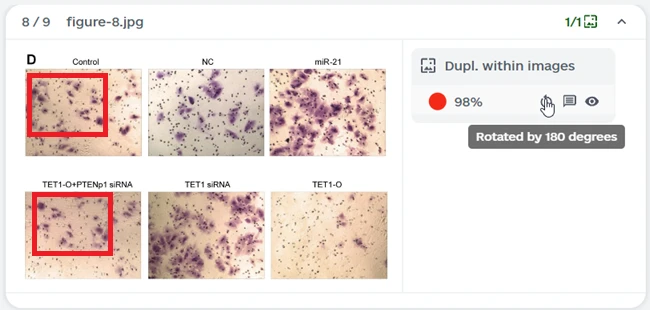
Detect Plagiarism Across Academic Literature
- Screens over 100 million scientific images to identify cross-paper duplication
- Flags matches with bounding boxes, similarity scores, and original source citations
- Traces duplicate origins using DOI, PubMed, PMC metadata, and research identifiers
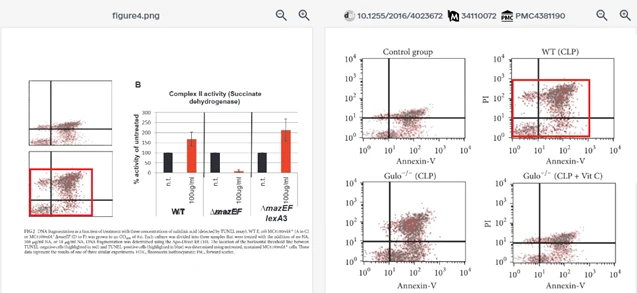
Detect Transformed Images
Imagetwin identifies duplicates even when images have undergone transformations such as:
- Rotation and mirroring
- Scaling and resizing
- Brightness and contrast adjustments
- Color modifications and filters
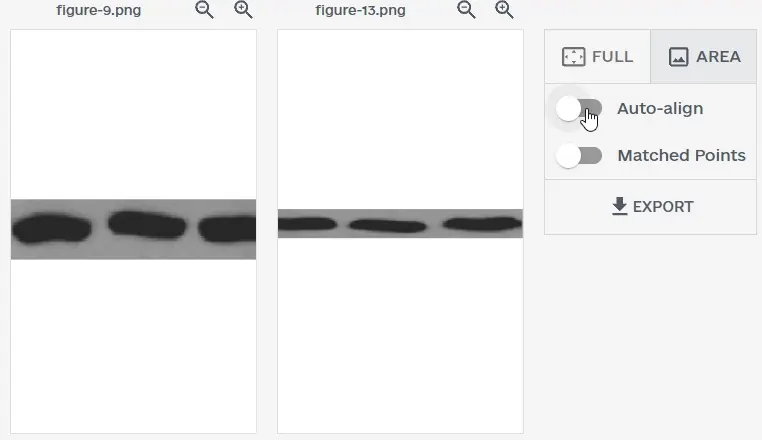
Covers All Major Scientific Image Types
We detect duplicates in all image types commonly affected by integrity issues.
- Microscopy images
- Western blots & gel electrophoresis
- Flow cytometry (FACS & FC)
- Histology & pathology slides
- Scientific photographs & cell cultures

Detect Image Manipulations
Identify Splicing in Research Images
Splicing can introduce misleading visual data.
- Automatically detects splicing seams
- Flags manipulated sections in western blots and gel electrophoresis images
- Uses the Forensic Toolbox for deeper examination
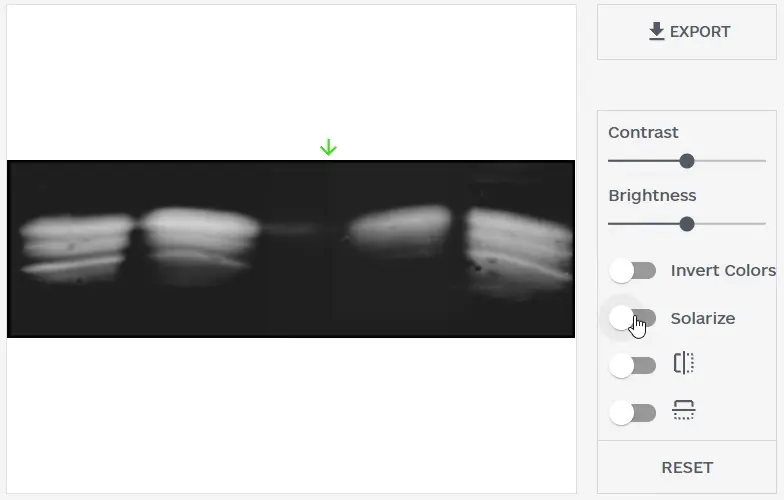
Detect Copy-Move Forgeries
Copy-move forgeries involve cloning image sections to conceal data.
- Identifies cloned, resampled, or stamped areas
- Uses AI-powered object detection to highlight modified zones
- Assigns confidence scores to suspected forgeries
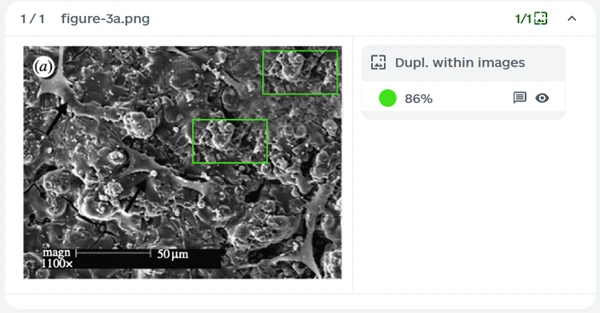
Analyze Detected Cases
- Auto-align transformed images to normalize rotated, flipped, or scaled duplicates
- Show matched keypoints to highlight identical regions between flagged duplicates
- Adjust brightness and contrast to enhance image visibility
- Use solarization and background visualization to uncover hidden modifications
- Adjust orientation to examine alignment and potential tampering
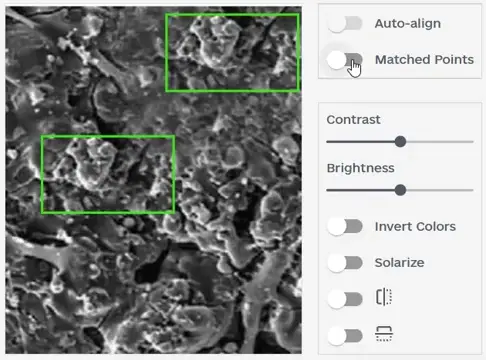
Verify the Authenticity of Your Images
Detecting AI-generated images in scientific research is an emerging challenge. Our AI Image Analyser helps:
- Identify potentially AI-generated visuals.
- Assess flagged cases with confidence scores.
- See which AI generator may have created an image
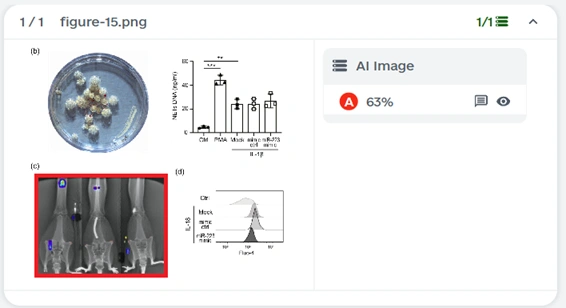
AI Model Attribution and Transparency
Our AI-generated image detection is built to help you see not only whether an image is likely synthetic, but also which generator may have produced it.
- Each flagged image includes an assessment of the most probable AI generator, or generators
- Detail view makes it easier to understand and interpret flagged cases with visual evidence
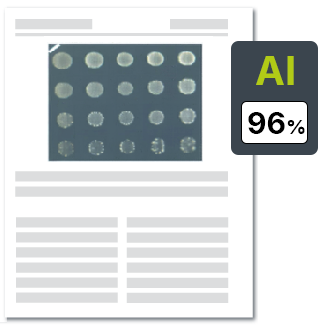
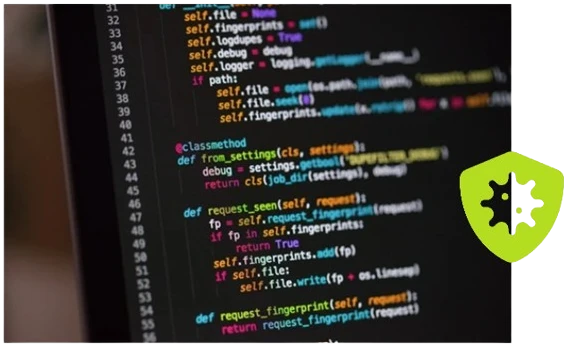
Stay Ahead of AI Threats
Our system is fine-tuned for leading AI models and continuously updated to adapt to evolving generative techniques. Model attribution and improved detection transparency help you confidently assess flagged images.
Imagetwin’s effectiveness has been shown in studies by Sholto David, Berrío & Kalliokoski, and Cho et al.
The leading image integrity experts use Imagetwin and post their findings on PubPeer.
Using Imagetwin is Simple
With user-friendly AI tools for image analysis, integrity checks in scientific papers are accessible without sacrificing effectiveness.
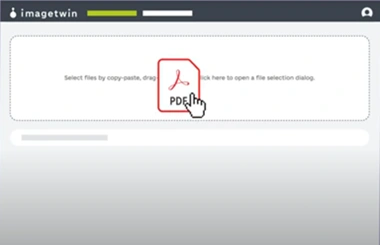
1. Select
Upload a single PDFs or multiple image files in JPG, TIF, PNG, GIF, and more.
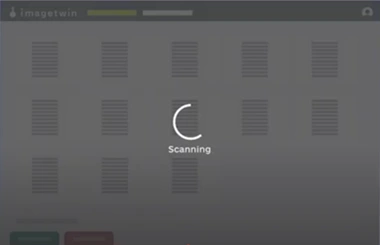
2. Scan
Initiate a full AI-driven image processing scan with one click.
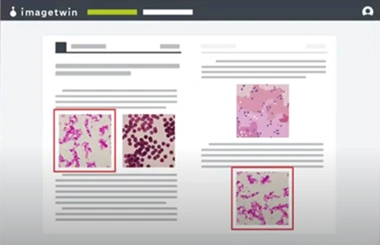
3. Examine
Receive results in seconds via our web interface with highlighted integrity concerns.
Key Features of Imagetwin's AI Image Analyser
Confidence Scores
Assigns a probability score from 0-100% to help assess the severity of detected issues, allowing reviewers to prioritize
PDF Reports
Generates a detailed summary of all detected integrity concerns in a structured PDF report
API Access
Integrates into existing workflows, enabling large-scale automated integrity checks through bulk processing and APIs
Private Repository
Create your own database of articles and compare new submissions with your repository to detect duplicates
Scan History
Users can save scans, enabling them to reopen, review, and compare past results as required
Filters
Use advanced filtering options to exclude irrelevant detections, sort flagged images, and quickly navigate results

Start using Imagetwin and preserve the integrity of your publications.
How long does it take to scan a manuscript or paper with Imagetwin?
The processing time depends on the number of images and figures within a manuscript. On average, Imagetwin completes a full scan in 5 to 20 seconds, ensuring a fast and efficient integrity check.
How many images are in the Imagetwin database?
Imagetwin has indexed over 100 million images from academic literature. This number continues to grow as we regularly update our database with newly published images from open-access papers and partner organizations.
Where does Imagetwin source its database images?
Our image database is built through partnerships with academic publishers and journals, granting access to indexed publications. Additionally, we integrate open-source publications to expand our detection capabilities.
Why should publishers share their publication database with Imagetwin?
By allowing Imagetwin to index your publication database, publishers can detect unauthorized image reuse, duplication, and plagiarism across their entire portfolio. This helps maintain research integrity at scale.
We prioritize data privacy and security, ensuring that all image indexing and exchanges are protected with industry-standard encryption and security best practices.
Why doesn’t Imagetwin detect all image integrity issues?
Our current detection accuracy ranges between 80% to 90%, depending on image type and manipulation complexity. Some factors that influence detection include:
- Image size, quality, and resolution
- Applied transformations (cropping, rotation, scaling)
- Content complexity
- While no detection tool is perfect, we are continuously improving our AI models to enhance accuracy and expand detection capabilities.
What is Imagetwin’s detection rate?
Measuring detection accuracy in scientific imaging is complex due to the lack of standardized benchmarks. However, based on internal evaluations using flagged integrity issues from PubPeer, Imagetwin achieves a detection rate of 80% to 90%, depending on the image type and the nature of the integrity concern.
How does Imagetwin evaluate its accuracy?
We assess accuracy using previously retracted papers and flagged cases from PubPeer. By testing on real-world examples of manipulations, AI-generated images, and duplicates, we refine our detection capabilities to ensure higher reliability.
Are scanned manuscripts stored in Imagetwin’s image database?
No. Imagetwin does not store or index scanned manuscripts in its database. All uploaded files remain private, and scanned images are never added to our global dataset.
For more details, refer to our data privacy policy data privacy policy.
What types of integrity issues does Imagetwin detect?
Imagetwin analyzes multiple scientific image types for duplications, plagiarism, manipulations, and integrity violations. The table below outlines detection capabilities:
| Image Type | Duplicates within manuscripts | Duplicates across literature | Copy-move forgery detection | Image splicing detection |
|---|---|---|---|---|
| All kinds of microscopy images, fluorescence-activated cell sorting (FACS), photographs, light photography, flow cytometry (FC), histology/pathology slides, in-vitor/in-vivo images, cell cultures, spot images | ✓ | ✓ | ✓ | ✕ |
| Western blots, gel electrophoresis | ✓ | ✓ | ✓ | ✓ |
| Graphs, plots, diagramms, charts | ✕ | ✓ | ✕ | ✕ |
What kind of images does Imagetwin analyze?
Imagetwin detects scientific figures, including microscopy images, FACS plots, Western blots, gel images, histology slides, and graphs.
What file formats does Imagetwin support?
Supported formats include PDF, DOCX, JPG, PNG, GIF, BMP, TIF, JFIF, SVG, and WEBP.
Can I request a product demo of Imagetwin?
Yes. Contact us to schedule a personalized AI-powered image analysis demo.
How does Imagetwin detect image manipulations?
Imagetwin automatically detects splicing, copy-move forgeries, and subtle image adjustments in scientific figures.
Using AI and forensic analysis, it flags manipulated regions, such as cloned or resampled areas and splicing seams in western blots.
Built-in tools allow users to auto-align transformed images, highlight duplicated keypoints, adjust brightness and contrast, and reveal hidden edits through background visualization.
What happens to my images after scanning with Imagetwin?
All uploaded images are automatically deleted once processing is complete. However, you can optionally save your scan results in your account for 90 days before they are permanently removed.
Can Imagetwin be used for non-scientific images?
While optimized for scientific imaging, it can detect manipulation in most structured images, but is not designed for creative or artistic analysis.
How does Imagetwin handle rotated, flipped, or scaled duplicates?
Imagetwin normalizes transformed images, ensuring accurate comparisons even when figures have been rotated, flipped, or resized.
How does Imagetwin highlight duplicated regions?
The software automatically detects and marks identical keypoints in flagged images, helping users verify potential manipulation.
Can Imagetwin enhance image visibility for better detection?
Yes, Imagetwin adjusts brightness and contrast to reveal subtle integrity issues that may not be visible in the original image.